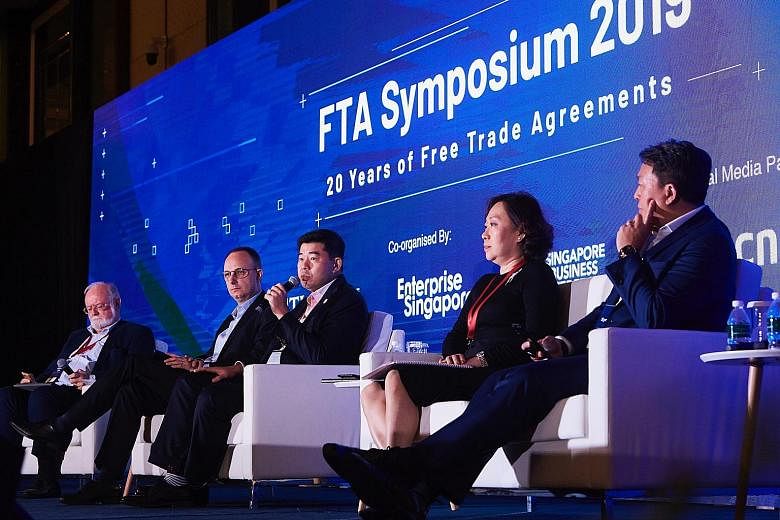As international trade evolves, Singapore is working with like-minded partners to shape new digital trade architecture in the same spirit with which it embarked on its first free trade agreement (FTA) 20 years ago, said Minister-in-charge of Trade Relations S. Iswaran.
The Republic started work on its first bilateral FTA with New Zealand in 1999, when the trade orthodoxy, now debunked, was that such agreements were discriminatory.
Singapore has now embarked on digital economy agreements with like-minded countries including Australia, Chile and New Zealand, and negotiations are progressing well, said Mr Iswaran yesterday.
These pacts will put in place clear and harmonised rules, and guard against digital and data barriers. They will also address emerging areas such as artificial intelligence and digital identities, he added.
Speaking to more than 600 business leaders and officials at the FTA Symposium, Mr Iswaran, who is also Communications and Information Minister, said Singapore's network of over 24 FTAs with 36 trading partners attests to its commitment to an open, connected and globalised world.
He added that trade, which stands at more than three times the Republic's gross domestic product, is Singapore's lifeblood.
And its FTAs have given businesses here access to millions of consumers across the globe, preferential access to service sectors, expanded government procurement opportunities, and improved intellectual property protections.
But current trade rules and policies do not address the needs of the booming digital economy, where business-to-consumer e-commerce sales are projected to reach US$1 trillion (S$1.36 trillion) by 2020. In Asean alone, it is estimated that the digital economy will grow to US$300 billion by 2025.
-
Initiatives to help firms utilise free trade pacts
-
TARIFF FINDER
Free online database for companies to calculate savings on duties through free trade agreements (FTAs) and review trade rules of export partners. It will be available on the Networked Trade Platform by the year end. The platform brings together different government certification services required for trading in and out of Singapore.
OUTREACH SESSIONS
These help companies understand how to enjoy FTA benefits.The Singapore Business Federation (SBF) has launched an FTA education and outreach arm, to provide more targeted advisory services to businesses.
1-TO-1 CONSULTATIONS WITH ENTERPRISE SINGAPORE, SBF
Customised advisory services for firms as they venture abroad.
FTA COURSES
These online and offline courses can help businesses better understand FTAs and develop stronger strategies. The International Chamber of Commerce Academy offers a certified online course on FTA regulations.
PUBLIC CONSULTATIONS
These aim to gather trade-related feedback for the Government's negotiation and review of FTAs.
Singapore's efforts to develop new rules also extend to the World Trade Organisation, where, together with Australia and Japan, it is negotiating the Joint Statement Initiative on E-Commerce to develop digital trade rules.
Said Mr Iswaran: "We were clear then, as we are now, that our pursuit of FTAs can and should complement and not supplant multilateralism. Bilateral and plurilateral FTAs are a practical way for like-minded parties to work towards a more ambitious level of trade liberalisation."
A study conducted by the Ministry of Trade and Industry estimates that, on average, Singapore businesses' exports of goods to a trade agreement partner increases by 18 per cent two years after the agreement's entry into force, and a further 16 per cent in the third year.
In 2016, FTAs collectively saved businesses about $720 million in tariffs, an increase from the $450 million enjoyed a decade before.
But Singapore cannot rely on trade strategy alone to progress, said Mr Iswaran. Free and open trade fosters economic growth but does not always generate equitable outcomes. Singapore thus invests in training and retraining workers, and helps businesses adapt.
"Where necessary, we make government transfers to ensure we share the benefits across society and uplift the most vulnerable. These measures help to ensure that the benefits of free trade are equitably distributed, and that we progress as one cohesive society."
Grace Ho


